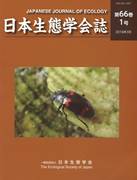Volume 66, Issue 1
Displaying 1-30 of 30 articles from this issue
- |<
- <
- 1
- >
- >|
Suzuki Award
-
2016 Volume 66 Issue 1 Pages 1-23
Published: 2016
Released on J-STAGE: June 01, 2016
Download PDF (3730K)
-
2016 Volume 66 Issue 1 Pages 25-27
Published: 2016
Released on J-STAGE: June 01, 2016
Download PDF (716K) -
2016 Volume 66 Issue 1 Pages 28-30
Published: 2016
Released on J-STAGE: June 01, 2016
Download PDF (680K)
Feature1 Dynamics and effects of pollutants in ecosystem
-
2016 Volume 66 Issue 1 Pages 31-35
Published: 2016
Released on J-STAGE: June 01, 2016
Download PDF (971K) -
2016 Volume 66 Issue 1 Pages 37-49
Published: 2016
Released on J-STAGE: June 01, 2016
Download PDF (2004K) -
2016 Volume 66 Issue 1 Pages 51-68
Published: 2016
Released on J-STAGE: June 01, 2016
Download PDF (2634K) -
2016 Volume 66 Issue 1 Pages 69-79
Published: 2016
Released on J-STAGE: June 01, 2016
Download PDF (1189K) -
2016 Volume 66 Issue 1 Pages 81-90
Published: 2016
Released on J-STAGE: June 01, 2016
Download PDF (1636K) -
2016 Volume 66 Issue 1 Pages 91-94
Published: 2016
Released on J-STAGE: June 01, 2016
Download PDF (823K) -
2016 Volume 66 Issue 1 Pages 95-108
Published: 2016
Released on J-STAGE: June 01, 2016
Download PDF (980K) -
2016 Volume 66 Issue 1 Pages 109-117
Published: 2016
Released on J-STAGE: June 01, 2016
Download PDF (857K)
Feature2 Biosphere Reserve as an effective institution for realizing sustainable society
-
2016 Volume 66 Issue 1 Pages 119-120
Published: 2016
Released on J-STAGE: June 01, 2016
Download PDF (693K) -
2016 Volume 66 Issue 1 Pages 121-134
Published: 2016
Released on J-STAGE: June 01, 2016
Download PDF (3459K) -
2016 Volume 66 Issue 1 Pages 135-146
Published: 2016
Released on J-STAGE: June 01, 2016
Download PDF (3664K) -
2016 Volume 66 Issue 1 Pages 147-154
Published: 2016
Released on J-STAGE: June 01, 2016
Download PDF (1371K) -
2016 Volume 66 Issue 1 Pages 155-164
Published: 2016
Released on J-STAGE: June 01, 2016
Download PDF (901K) -
2016 Volume 66 Issue 1 Pages 165-172
Published: 2016
Released on J-STAGE: June 01, 2016
Download PDF (1027K)
News1 Supports for careers of young scientists
-
An attitude survey about support for career formation of young member of Ecological Society of Japan2016 Volume 66 Issue 1 Pages 173-180
Published: 2016
Released on J-STAGE: June 01, 2016
Download PDF (1768K) -
2016 Volume 66 Issue 1 Pages 181-191
Published: 2016
Released on J-STAGE: June 01, 2016
Download PDF (856K) -
2016 Volume 66 Issue 1 Pages 193-201
Published: 2016
Released on J-STAGE: June 01, 2016
Download PDF (1737K) -
2016 Volume 66 Issue 1 Pages 203-207
Published: 2016
Released on J-STAGE: June 01, 2016
Download PDF (765K)
News2 Ecology of Information Age-Biodiversity Informatics and Global Biodiversity Information Facility(GBIF)-
-
2016 Volume 66 Issue 1 Pages 209-214
Published: 2016
Released on J-STAGE: June 01, 2016
Download PDF (884K) -
2016 Volume 66 Issue 1 Pages 215-220
Published: 2016
Released on J-STAGE: June 01, 2016
Download PDF (1014K) -
2016 Volume 66 Issue 1 Pages 221-227
Published: 2016
Released on J-STAGE: June 01, 2016
Download PDF (1534K) -
2016 Volume 66 Issue 1 Pages 229-236
Published: 2016
Released on J-STAGE: June 01, 2016
Download PDF (934K) -
2016 Volume 66 Issue 1 Pages 237-246
Published: 2016
Released on J-STAGE: June 01, 2016
Download PDF (1392K) -
2016 Volume 66 Issue 1 Pages 247-252
Published: 2016
Released on J-STAGE: June 01, 2016
Download PDF (978K) -
2016 Volume 66 Issue 1 Pages 253-258
Published: 2016
Released on J-STAGE: June 01, 2016
Download PDF (1764K)
From field research sites (32)
-
2016 Volume 66 Issue 1 Pages 259-264
Published: 2016
Released on J-STAGE: June 01, 2016
Download PDF (1855K)
Museum and ecology (25)
-
2016 Volume 66 Issue 1 Pages 265-270
Published: 2016
Released on J-STAGE: June 01, 2016
Download PDF (784K)
- |<
- <
- 1
- >
- >|
